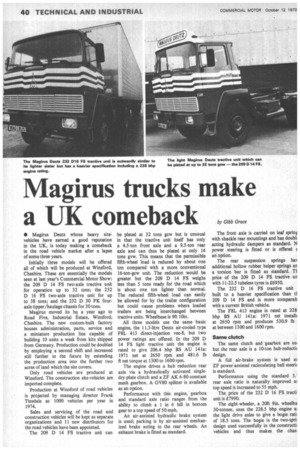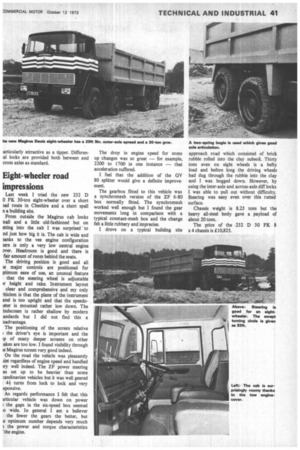Magirus trucks make
Page 38

Page 39

If you've noticed an error in this article please click here to report it so we can fix it.
a UK comeback by Gibb Grace
• Magirus Deutz whose heavy sitevehicles have earned a good reputation in the UK, is today making a comeback in the road vehicle market after a lapse of some three years.
Initially three models will be offered all of which will be produced at Winsford, Cheshire. These are essentially the models seen at last year's Commercial Motor Show: the 209 D 14 FS two-axle tractive unit for operation up to 32 tons; the 232 D 16 FS two-axle tractive unit for up to 38 tons; and the 232 D 30 FK fouraxle tipper /haulage chassis for 30 tons.
Magirus moved its hq a year ago to Road Five, Industrial Estate, Winsford, Cheshire. The new custom-built factory houses administration, parts, service and a miniature production line capable of building 10 units a week from kits shipped from Germany. Production could be doubled by employing a second shift and increased still further in the future by extending the production area into the further two acres of land which the site covers.
Only road vehicles are produced at Winsford. The construction site-vehicles are imported complete.
Production at Winsford of road vehicles is projected by managing director Frank Tinsdale as 1000 vehicles per year in 1974.
Sales and servicing of the road and construction vehicles will be kept as separate organizations and 11 new distributors for the road vehicles have been appointed.
The 209 D 14 FS tractive unit can be plated at 32 tons gcw but is unusual in that the tractive unit itself has only a 4.5-ton front axle and a 9.5-ton rear axle and can thus be plated at only 14 tons gvw. This means that the permissible fifth-wheel load is reduced by about one ton compared with a more conventional 16-ton-gcw unit, The reduction would be greater but the 209 D 14 FS weighs less than 5 tons ready for the road which is about one ton lighter than normal. The reduced fifth-wheel load can easily be allowed for by the trailer configuration but could cause problems where loaded trailers are being interchanged between tractive units. Wheelbase is 9ft 10in.
All three models use the same basic engine, the 11.3-litre Deutz air-cooled type F8L 413 direct-injection vee-8, but two power ratings are offered. In the 209 D 14 FS light tractive unit the engine is rated to give 206.4 bhp BS AU 141a: 1971 net at 2650 rpm and 481.6 lb ft net torque at 1300 to 1600 rpm.
The engine drives a hub reduction rear axle via a hydraulically activated singledry-plate clutch and a ZF AK 6-80 constant mesh gearbox. A GV80 splitter is available as an option.
Performance with this engine, gearbox and standard axle ratio ranges from the ability to climb a 1 in 6 hill in bottom gear to a top speed of 50 mph.
An air-assisted hydraulic brake system is used; parking is by air-assisted mechanized brake acting in the rear wheels. An exhaust brake is fitted as standard.
The front axle is carried on leaf sprini with shackle rear mountings and has doubli acting hydraulic dampers as standard. N power steering is fitted or is offered I an option.
The rear suspension springs hal additional hollow rubber helper springs an a torsion bar is fitted as standard. Tt price of the 209 D 14 FS. tractive un with 11-22.5 tubeless tyres is £6950.
The 232 D 16 FS tractive unit built to a heavier specification than ti 209 D 14 FS and is more comparab with a current British vehicle.
The F8L 413 engine is rated at 228 bhp BS AU 141a: 1971 net install( at 2650 rpm and produces 530.9 lb at between 1300 and 1600 rpm.
Same clutch The same clutch and gearbox are usi but the rear axle is a 10-ton hub-reductic design.
A full air-brake system is used at ZF power-assisted recirculating ball steerii is standard.
Performance using the standard 5.' rear axle ratio is naturally improved ai top speed is increased to 55 mph.
The, price of the 232 D 16 FS tracti unit is £7990.
The eight-wheeler, a 20ft 9in. wheelba 30-tonner, uses the 228.5 bhp engine al the light drive axles to give a bogie rati: of 18.5 tons. The bogie is the two-spri design used successfully in the constructil vehicles and thus makes the chas' Last week I tried the new 232 D 0 FK 30-ton eight-wheeler over a short )ad route in Cheshire and a short spell n a building site.
From outside the Magirus cab looks nail and a little old-fashioned but on !tang into the cab I was surprised to nd just how big it is. The cab is wide and tanks to the vee engine configuration tere is only a very low central engine aver. Headroom is good and there is fair amount of room behind the seats.
The driving position is good and all le major controls are positioned for ptimum ease of use, an unusual feature that the steering wheel is adjustable ir height and rake. Instrument layout clear and comprehensive and my only iticism is that the plane of the instrument anel is too upright and that the speedoieter is mounted rather low down. The indscreen is rather shallow by modern andards but I did not find this a sadvantage.
The positioning of the screen relative the driver's eye is important and the ip of many deeper screens on other akes are too low. I found visibility through ie Magirus screen very good indeed.
On the road the vehicle was pleasantly liet regardless of engine speed and handled !ry well indeed. The ZF power steering as set up to be heavier than some ;andinavian vehicles but it was well geared 4+ turns from lock to lock and very sponsive.
As regards performance I felt that this trticular vehicle was down on power ; the gaps in the six-speed box seemed o wide. In general I am a believer the fewer the gears the better, but e optimum number depends very much the power and torque characteristics 'the engine.
The drop in engine speed for some up changes was so great — for example, 2200 to 1700 in one instance — that acceleration suffered.
I feel that the addition of the GV 80 splitter would give a definite improvement.
The gearbox fitted to this vehicle was a synchromesh version of the ZF 6-80 box normally fitted. The synchromesh worked well enough but I found the gear movements long in comparison with a typical constant-mesh box and the change felt a little rubbery and imprecise.
I drove on a typical building site approach road which consisted of brick rubble rolled into the clay subsoil. Thirty tons even on eight wheels is a hefty load and before long the driving wheels had dug through the rubble into the clay and I was bogged down. However, by using the inter-axle and across-axle diff locks I was able to pull out without difficulty. Steering was easy even over this rutted surface.
Chassis weight is 8.25 tons but the heavy all-steel body gave a payload of about 20 tons.
The price of the 232 D 30 FK 8 x 4 chassis is £10,825,




















































































































